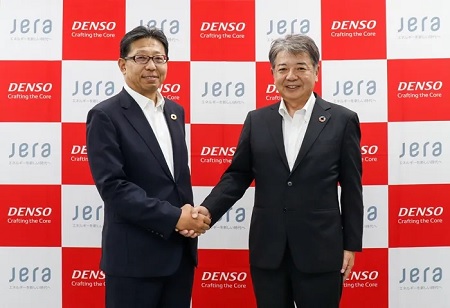
DENSO and JERA Launch Cutting-Edge Hydrogen Tech with Power Plant Demo

 DENSO Corporation and JERA Co., Inc. have announced a collaboration to develop advanced hydrogen generation technology. This technology will integrate Solid Oxide Electrolyzer Cells (SOEC) with waste heat recovery and will undergo joint demonstration testing at a JERA thermal power plant. DENSO, which has been focused on "Monozukuri" (manufacturing), mobility products, and energy use, aims to achieve carbon neutrality by 2035. Recognizing the critical role of hydrogen production in energy solutions, DENSO is leveraging its expertise from automotive system development to enhance the SOEC, known for its high stability and efficiency.
DENSO Corporation and JERA Co., Inc. have announced a collaboration to develop advanced hydrogen generation technology. This technology will integrate Solid Oxide Electrolyzer Cells (SOEC) with waste heat recovery and will undergo joint demonstration testing at a JERA thermal power plant. DENSO, which has been focused on "Monozukuri" (manufacturing), mobility products, and energy use, aims to achieve carbon neutrality by 2035. Recognizing the critical role of hydrogen production in energy solutions, DENSO is leveraging its expertise from automotive system development to enhance the SOEC, known for its high stability and efficiency.
As part of its JERA Zero CO2 Emissions 2050 goal, JERA is working to establish a hydrogen and ammonia supply chain to achieve net-zero CO2 emissions across both its domestic and international operations by 2050. In the thermal power sector, JERA is advancing the adoption of greener fuels as it strives to develop zero-emissions thermal power that produces no CO2 during electricity generation.
Utilizing a 200kW SOEC (Electrolyzing Power) developed by DENSO, the two companies will embark on a joint development project aimed at creating high-efficiency hydrogen production technology that leverages waste heat. Starting in FY 2025, DENSO and JERA will conduct joint demonstration testing at a JERA thermal power plant. Based on the results from the 200kW demonstration, the companies plan to scale up the technology to several thousand kilowatts by combining multiple SOECs.
Through this joint development and joint demonstration testing, the companies will work toward the early establishment of a global supply chain for green hydrogen and ammonia and contribute to finding solutions for global decarbonization and energy issues.
SOEC (Solid Oxide Electrolysis Cell): SOECs function at high temperatures using a ceramic membrane as the electrolyte to electrolyze water vapor and generate hydrogen. Unlike other hydrogen production methods, such as alkaline water electrolysis—which uses an alkaline liquid as the electrolyte—or PEM (Proton Exchange Membrane) water electrolysis—which employs a polymer membrane as the electrolyte—the SOEC requires less electrical energy for the electrolysis process. Electrolyzing Power refers to the electric power dedicated to the process of electrolyzing water.

